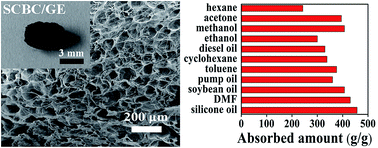Facile and scalable production of three-dimensional spherical carbonized bacterial cellulose/graphene nanocomposites with a honeycomb-like surface pattern as potential superior absorbents†
Abstract
Frequent contamination of water by oils and organic solvents necessitates efficient and low cost absorbents. Here, for the first time, a novel nanocomposite of sphere-like carbonized bacterial cellulose (SCBC) and graphene (GE) with a honeycomb-like surface morphology and a three-dimensional (3D) interconnected porous structure was synthesized via a facile and scalable one-pot in situ biosynthesis route under agitated culture conditions followed by carbonization. The as-prepared SCBC/GE nanocomposite was characterized by SEM, TEM, XRD, FTIR, Raman, wettability, and absorption capacity measurements. SEM images reveal that the SCBC/GE nanocomposite exhibits a honeycomb-like surface pattern consisting of ridges and large cavities with an average diameter of around 97 μm. Furthermore, the SCBC/GE nanocomposite has high porosity, large specific surface area, strong hydrophobicity, and good elasticity. Importantly, it shows superior absorption capacities for a wide range of oils and organic solvents (the maximum value reaches 457 times of its own weight), higher than any other CNF-based aerogels reported so far, thus having the potential to be used in the field of environmental protection. Additionally, the underlying absorption mechanisms for oil and organic solvents have been explored.


 Please wait while we load your content...
Please wait while we load your content...